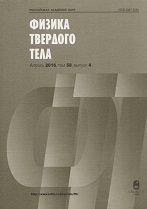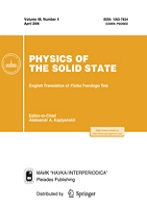|
This article is cited in 3 scientific papers (total in 3 papers)
Dielectrics
Effect of sodium iodide dopant concentration on the electrical behavior of AgPO$_3$ glassy networks
A. Shaheena, S. Qabajeha, Z. Khattaria, J. Al-Jundia, A. Aqilia, F. Salmanb
a Department of Physics, Faculty of Science, The Hashemite University, P.O. Box, Zarqa, Jordan
b Department of Physics, University of Banha, Banha, Egypt
Abstract:
The ionic and dielectric behavior of (AgPO$_3)_{(1-x)}$–NaI$_x$ ($x$ = 0, 0.02, 0.04, $\dots$, 0.14) systems were tested in the frequency range of 1–10$^6$ Hz at different temperatures using impedance spectroscopy technique. Samples were prepared using the melt quenching method to obtain the desired ratios between NaI and AgPO$_3$. Results of impedance measurements showed a switching from resistive-like (at low frequency) to capacitive-like (at higher frequency) behavior with a single relaxation peak that shifts to higher frequency with increasing either the temperature or the dopant concentration. In addition, the Nyquist plots showed a decrease in the values of the bulk resistance of the samples with increasing temperature and dopant concentration. The measured AC-conductivity shows a cross-over at frequency $f>10^5$ Hz. The conductivity shows an increase as function of temperature regardless the frequency range and it is almost constant at low frequency up to the crossover frequency, in addition to that, the power law dispersive behavior was also observed at higher frequency ($f>10^5$ Hz). The DC-conductivity can be explained in terms of silver ions successful diffusion process that take place due to the applied alternative electric field. On the other hand, the diffusion controlled relaxation (DCR) model can be used to explain the power law conductivity. Finally, the values of the activation energy calculated from the linear plot of Arrhenius equation were found to decrease with the dopant concentration from 0.65 eV at zero concentration to 0.36 eV at 14% concentration.
Keywords:
impedance, AC-conductivity, NaI, ionic compound, dielectric constant.
Received: 27.01.2021
Revised: 09.02.2021
Accepted: 11.02.2021
Citation:
A. Shaheen, S. Qabajeh, Z. Khattari, J. Al-Jundi, A. Aqili, F. Salman, “Effect of sodium iodide dopant concentration on the electrical behavior of AgPO$_3$ glassy networks”, Fizika Tverdogo Tela, 63:6 (2021), 747; Phys. Solid State, 63:6 (2021), 914–923
Linking options:
https://www.mathnet.ru/eng/ftt10144 https://www.mathnet.ru/eng/ftt/v63/i6/p747
|


| Statistics & downloads: |
| Abstract page: | 97 | | Full-text PDF : | 48 |
|





 Contact us:
Contact us: Terms of Use
Terms of Use
 Registration to the website
Registration to the website Logotypes
Logotypes








 Citation in format
Citation in format 
